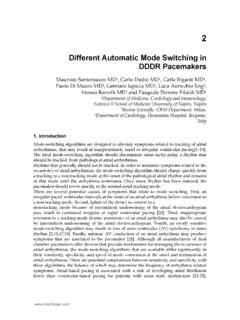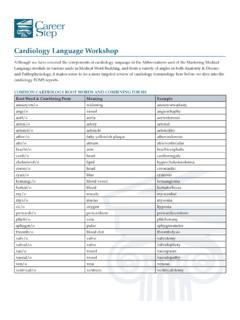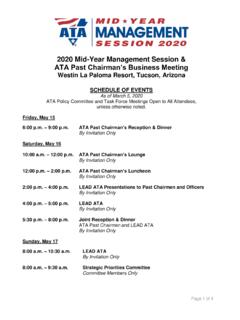Transcription of Safety Standards for Aquatic Therapy and Rehabilitation ...
1 Safety Standardsfor Aquatic Therapyand RehabilitationPractitionerspublished by the Aquatic Therapy & Rehab InstituteSafety Standards for Aquatic Therapy and RehabilitationPractitioners Published by the Aquatic Therapy & Rehab InstituteISBN: 1-889959-29-4 Author: Dr. Mary WykleEditor: Ruth SovaCommittee Chair: Dr. Mary WykleCommittee Members: Paula Briggs, Brian Sherlock, Mary Essert, SueGavron, Roxy Foltz, Brian Sherlock, Sharon Stewart Copyright 2004I. All Aquatic Therapy practitioners should maintain appropriate certifications to demonstrate professionalismA. Practitioners in Aquatic Therapy and Rehabilitation should becertified by a national organization recognized in their specific field,and in Aquatic Certification and licensure specific to the professional field of thepractitioner should be Practitioners should qualify for and maintain Aquatic Therapy and Rehabilitation industry Practitioners in Aquatic Therapy and Rehabilitation should holdcurrent certification in the following area of emergency responsetraining:1.
2 Risk Awareness and Safety Training or an equivalent First aid 3. CPR - (advanced life support / professional rescuer level recommended)4. Oxygen Administration 5. Automated External Defibrillation 6. Bloodborne PathogensII. Practitioners in Aquatic Therapy and Rehabilitation industry shouldhave knowledge and ability to maintain personal Safety and safetyof practitioner Safety . Personal Safety for the practitioner includesawareness of safe length of immersion time in an enclosed poolarea, self-rescue skills, appropriate attire for the environment, andemergency communication avenues. 1. Immersion time for practitioners depends on the situation and theindividual.
3 Water temperature, and water and air chemistry, aswell as personal medical status are factors determiningimmersion time. Current recommendation is: Maximum of 4continuous hours per day in an enclosed Self-rescue includes basic water adjustment skills of breathholding and recovery-to-standing abilities. Deep-waterprotocols should require swimming comfort without flotation tosave self. Practitioners in deep water should have a monitor orassistant on deck with ability to effect a Appropriate attire for the environment includes, but is not limitedto heat retention attire and foot Emergency communication avenues include ability to activatethe facility emergency action plan as soon as an emergency Client Safety .
4 Personal Safety for the client includes attention totransfer protocols, pool entry and exit, equipment use, andpositioning in water. 1. Transfers in and out of the pool should be appropriate and safefor the client and the practitioner . 2. Positional, equipment, and support transfers within the poolshould be appropriate to the needs of the client. 3. A position of Safety should always be maintained by thepractitioner when assisting client pool entries. Transfer methodshould be appropriate to the pool, ability of the practitioner toassist, and ability of client. 4. Equipment for pool entry and exit transfers should be non-slipand in safe working condition. 5.
5 The client should maintain a position of Safety so as not to gobeyond a safe depth and/or stability area in the pool. Safepositioning requires practitioner to have back-to-deep-end orback-to-steps, drop-offs, or slippery lane markers. C. Communication between practitioner and client should be eye-to-eye, with clear voice instructions and appropriate gestures Clients with visual impairment should be allowed to wear theirglasses in the pool. They may need their ears clear of thewater. practitioner should speak with audible, distinct distractions in pool areas should be minimal. Tactilemarkings should be used to show water depth and Clients with hearing impairments need visual contact withpractitioner.
6 3. Predetermined emergency signals should be arranged with allclients and are particularly important for clients who are Practitioners in Aquatic Therapy and Rehabilitation industry shouldhave knowledge of supervisory Client Surveillance should be provided in a safe and appropriatemanner at all practitioner -to-client ratio should, at the minimum, follow all localand state Staffing by trained lifeguards should comply with local and Water depth should be appropriate for treatment protocol, practitioner size and functioning, client ability, and monitoring ofthe entire treatment Staff trained to assist in emergencies should be present at alltimes when the practitioner is working on a one-to-one basis.
7 B. Precautions and Contraindications. Advantages vs. potential risksof Aquatic intervention should be determined to establishappropriateness of Aquatic Therapy and : Contraindications are guidelines to preclude treatment in thepool. Precautions are discretionary conditions. 1. Practitioners should consider current status of each clientregarding treatment in the pool. 2. Written policies and procedures for Aquatic Therapy andrehabilitation intervention should be the basis of determiningrecommended precautions and Proper care should require adherence to medicalrecommendations and Infection control policies should be followed at all times. C. Practitioners in Aquatic Therapy and Rehabilitation should have knowledge and understanding of bioethics as related to therapist/client interaction, including familiarization with:1.
8 Resuscitation Refusal of care Client choice of treatment options. Facility policies and procedures regarding documentation ofunderstanding and agreement with the Practitioners in Aquatic Therapy and Rehabilitation industry haveresponsibility for the Safety of their clients in the Practitioners should have the knowledge and ability to recognizeemergencies and precursors to emergency situations, and be ableto respond as practiced in the EAP. This includes familiarizationwith--1. Signs of physiologic stress demanding immediate attention(including, but not limited to, hypothermia and hyperthermia,seizure, low blood sugar, skin, eye and respiratory distress, heartattack or sudden cardiac events, stroke, and general fatigue orfear leading to distress)2.
9 The ability to perform Aquatic assists and rescues appropriate tothe water depth of their facility and as required by the currentsafety and rescue certification they hold (see Standard I).B. Practitioners should have adequate knowledge of facility evaluation to determine whether the environment is safe, including--1. Familiarization and documentation of compliance with federaland local regulations and Facility design compliance with ADA Standards . 3. Daily inspection of facility to determine safe usage of Inspection of facility using prepared checklist. Problems andcorrective action needed noted and referred immediately toappropriate Rescue equipment and first aid supplies are checked forlocation, serviceability, and complete Signage stating pool rules and cautions is clearly posted.
10 Anyhazards are clearly marked. d. Water chemistry, including water-testing procedures,chemical accident procedures, and general sanitizers is theresponsibility of the pool operator. Practitioners areresponsible for reviewing current postings and testing whenindicated to determine the Safety of the water. Practitionersare also responsible for immediately reporting any waterquality problems and immediately clearing the pool for anyinfectious agent Knowledge of optimum water and air temperatures andhumidity levels to determine the appropriateness of During severe weather and lightning storms following the SafetyStandards for Therapy Pools that is based onrecommendations by the National Weather Service and theNational Lightning Safety Institute.










